 If you’ve ever had the opportunity to audition Burmester loudspeakers, you know they mate perfectly with the company’s electronics and that, together, they put forward a very dynamic, powerful presentation. And, as founder Dieter Burmester is a bass player in his spare time, his speakers are never lacking in low-frequency authority.
If you’ve ever had the opportunity to audition Burmester loudspeakers, you know they mate perfectly with the company’s electronics and that, together, they put forward a very dynamic, powerful presentation. And, as founder Dieter Burmester is a bass player in his spare time, his speakers are never lacking in low-frequency authority.
In a fairly good-sized room, pairing the hefty Burmester 911 amplifier (or the larger 909) with Burmester speakers makes for highly engaging listening. But for those of us wanting the Burmester experience in a smaller room, the B10s—which are only about 15 inches tall, 9 inches wide, and 11 inches deep—deliver just that. They fit on a pair of stands; I use sand-filled Sound Anchors in my modest 11-by-13-foot listening room.
This understated-looking pair of two-way speakers is something of a happy accident. Originally designed as personal reference monitors for Dieter’s studio, they became part of the product lineup and they make for an excellent match with Burmester’s smaller 101 integrated amplifier and 102 CD player, which we review here. With an 87-dB sensitivity and 4-ohm nominal sensitivity, the B10s are obviously geared towards Burmester amplification, but they work great in the context of any system, whether tube or solid state.
For initial break-in, I run the B10s for a few days with the Devialet 110 (now upgraded to 120 status) in my second listening room, merely swapping out the Stirling Broadcast 88-B8 speakers (also 87 dB) that have been in for review for some time. This could not have been a more night-and-day difference; it was like going from a mid-1980s Mercedes 300 turbo diesel (the Sterlings) to a current AMG C63 (the Burmesters). There’s more resolution and extension everywhere, and even though these are fairly small speakers, the signature Burmester low-end performance is there in spades.
The Burmester B10s have an MSRP of $9,000, without stands.
Initial Listening
Once settled in, my Devialet/Meridian combination goes out and in comes the Burmester 101/102 combination, which proves very interesting, as this amplifier is Burmester’s foray into class-D design—no doubt as a result of the company’s work on high-end automotive audio systems. For those already familiar with the Burmester house sound, (read: slightly warm for solid state), the 101 does not disappoint; it lacks the slight haziness and harshness normally associated with these designs.
Listening to Thomas Dolby’s “I Scare Myself,” I find that the B10s exhibit excellent pace, keeping the deep bass line firmly anchored in place, as the synthesizers float about the soundstage with plenty of width and depth. Interestingly, the B10s use a dome tweeter where the rest of the Burmester line uses a ribbon/AMT driver. Ribbons in general tend to elicit a polarized response from most music lovers, and reviewer bias admitted, it is not my favorite driver, so I find myself very drawn to the overall sound of the B10s, especially since I have a soft spot for well-designed two-way loudspeakers.
Setup is simple and straightforward. As with any compact high-performance monitor, a pair of rigid stands is a must in order to extract the best possible performance. Burmester does make its own stands, which are more attractive than my Sound Anchors, but the Sound Anchors are very dense stands and so they are a great match for the B10s. Putting the speakers on less-massive stands does, in fact, compromise bass extension and focus, so regardless of which way you go, don’t set these speakers on weak stands or you will be disappointed.

Seat Time
The more time spent with the B10s, the more comfortable I become. Expanding the musical palette reveals no shortcomings, with the only thing missing being the extremely low frequencies of large floorstanding speakers. Yet, taking advantage of the room gain in a small room, the B10s do not disappoint, even when playing tracks from Deadmau5, Pink Floyd and Mickey Hart. Though it might seem counterintuitive with a $9,000 pair of speakers, the B10s deliver more low-end heft with a larger amplifier—in this case, my reference Burmester 911 MK3, which has been in service for some time now.
Listening to the new Black Keys album Turn Blue is much freakier with the added power of the 911 driving the B10s. The fuzzy guitars come alive with more weight, bite and roundness, while the vocals seem more real and full of life. A similar experience is had with Pink Floyd’s classic album Wish You Were Here. The title track comes in with barely a whisper as the acoustic guitar spikes up, standing out clearly in its own acoustic space. The smaller 101 amplifier, though similar tonally to the 911, flattens the leading in and trailing off of sound ever so slightly, though it is still involving and something you wouldn’t notice if you didn’t happen to have a 911 hanging around.
As hinted at earlier, the B10s will work fine with vacuum-tube amplification, suggesting that they have a well-designed crossover network, though you can expect that a slightly softer sound will reflect what comes out. The 35-watt-per-channel Van Alstine Ultravalve renders a very mellow performance, per its character, while the 125-wpc Conrad Johnson LP120SA+ is much more authoritative and incredibly deep. While these comparisons offer different flavors than the Burmester amplification, the experiment is a ton of fun, turning my listening room into a fishbowl full of music—not necessarily real, but highly engaging.
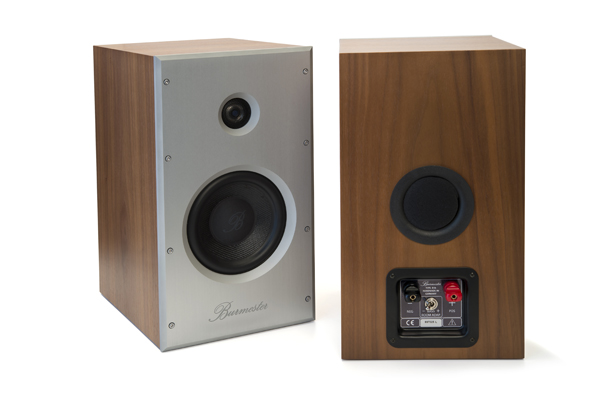
Keeping It Real
The B10s rock with authority and image like crazy, but they do not present an overblown sense of perspective, preserving tone and timbre with acoustic instruments. The Jung Trio’s Dvorak Trio in F Minor Op. 65 quickly demonstrates how well these small monitors keep violin and piano sorted, especially the violin. This masterfully recorded piece is so clean that any hint of harshness in a system will be revealed instantly. The B10s pass this tough test with ease.
The subtle brushwork at the beginning of Thad Jones’ “April in Paris” is equally impressive. As Jones’ smooth horn gently glides into the mix, it’s easy to hear him move ever so slightly across the soundstage, and the B10s nail the subtle phrasing of this jazz master, delivering a very emotional experience.
Chrissie Hynde’s highly processed vibrato in the Pretenders’ self-titled debut is perfectly rendered through the B10s. Each of her breaths on the track “Private Life” comes through the mix with an exciting sense of immediacy. Shelby Lynne’s not bad either, so the audiophile whose taste leans more towards female vocalists will not be disappointed with these speakers.
Going through record after record, I find that the design and meticulous build quality that goes into the B10s (like that of every single Burmester product) is evident. These speakers may look understated and simple, but the musical result is fantastic. A perfect match for an all-Burmester system, the B10s will also mate fantastically well with a non-Burmester system. They may even pull you further into the world of Burmester.
Burmester B10 speakers
MSRP: $9,000 per pair
www.rutherfordaudio.com (North American importer)
PERIPHERALS
| Digital sources | Meridian Control 15 Burmester 102 CD Player |
| Amplification | Devialet 120 Burmester 101 Burmester 011/911 |
| Cable | Cardas Clear |





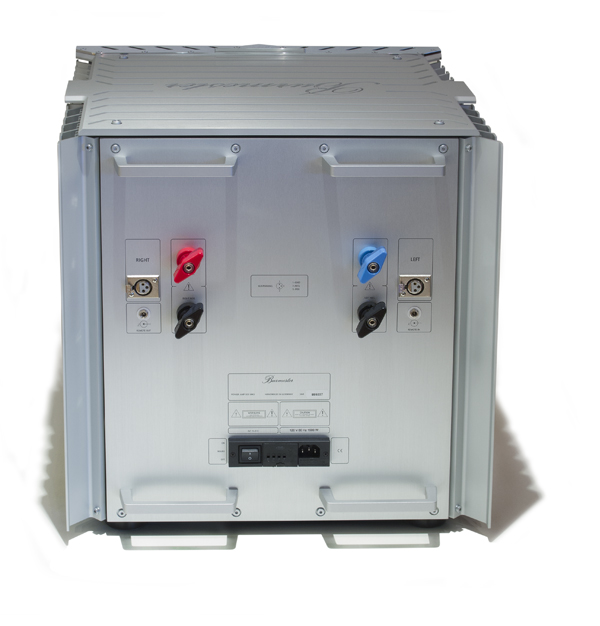
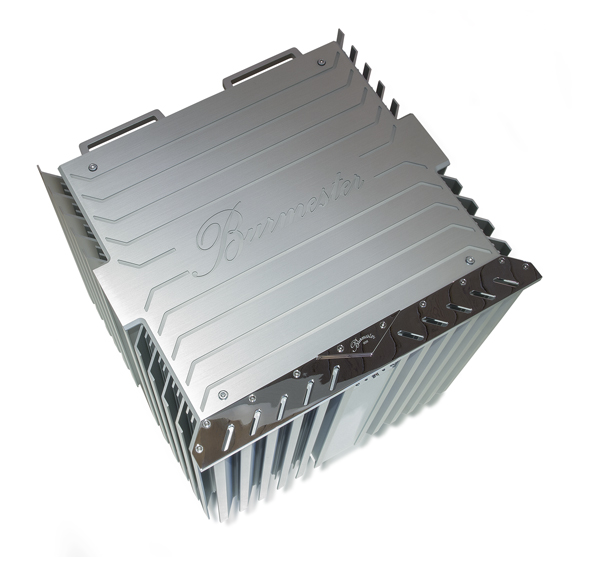


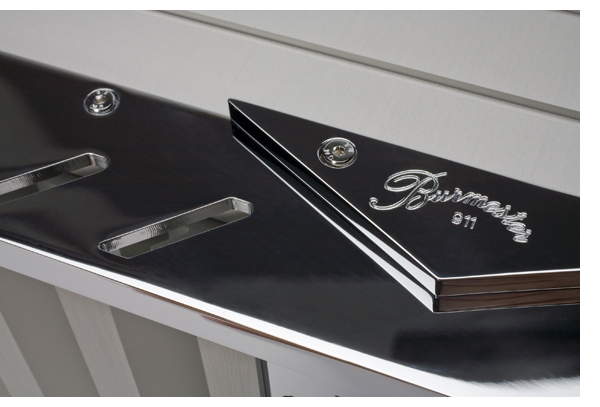



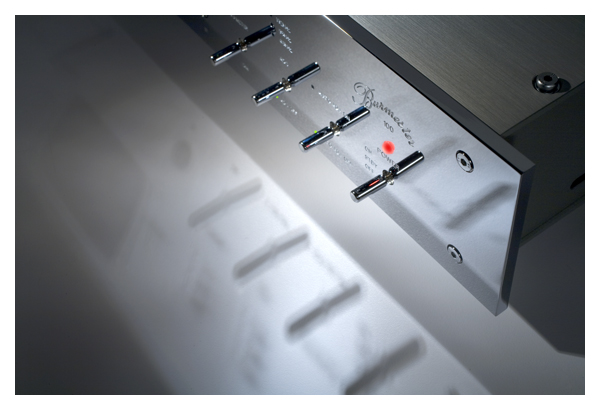 It’s been a long time since Burmester has produced a phono stage.
It’s been a long time since Burmester has produced a phono stage. The subsonic filter worked well with a few older, more warped records that have not had a session with the Furutech flattener yet and I was unable to hear any difference in low frequency output. If the wide range of gain settings still isn’t enough, the 100 has the ability to boost the output by an additional 6db, so there should never be a situation where the 100 Phono does not possess enough gain.
The subsonic filter worked well with a few older, more warped records that have not had a session with the Furutech flattener yet and I was unable to hear any difference in low frequency output. If the wide range of gain settings still isn’t enough, the 100 has the ability to boost the output by an additional 6db, so there should never be a situation where the 100 Phono does not possess enough gain. All controls are easily available on the front panel and clearly marked, so finding the proper loading and gain settings for your cartridge couldn’t be easier. If you have multiple turntable/cartridge owners will be instantly at ease with this flexibility that few other phono stages match.
All controls are easily available on the front panel and clearly marked, so finding the proper loading and gain settings for your cartridge couldn’t be easier. If you have multiple turntable/cartridge owners will be instantly at ease with this flexibility that few other phono stages match.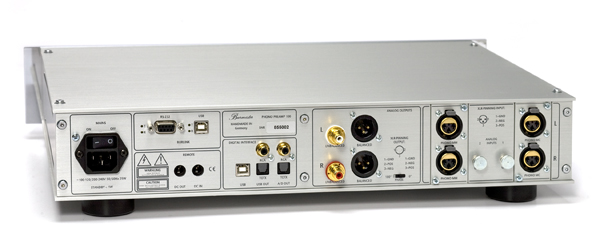 Burmester feels that keeping the signal path balanced all the way through, so the 100 only has balanced inputs. This will require cable retermination or using the supplied XLR to RCA adaptors. Considering the additional benefit to running a phono cartridge balanced, I would highly suggest having your tonearm cable terminated for balanced operation. I used a Cardas Clear Phono cable and the Burmester Silver Balanced Phono Cable ($1,595) The Burmester cable was perhaps a bit too revealing for my taste, but again like any other cable, this is a tone control that needs to be fitted to your taste.
Burmester feels that keeping the signal path balanced all the way through, so the 100 only has balanced inputs. This will require cable retermination or using the supplied XLR to RCA adaptors. Considering the additional benefit to running a phono cartridge balanced, I would highly suggest having your tonearm cable terminated for balanced operation. I used a Cardas Clear Phono cable and the Burmester Silver Balanced Phono Cable ($1,595) The Burmester cable was perhaps a bit too revealing for my taste, but again like any other cable, this is a tone control that needs to be fitted to your taste.









